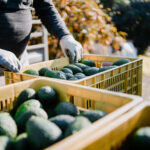A look at Hawaii’s avocado sector potential

Hawaii’s avocado sector is well known for its foodservice-quality varieties and large size fruit, which usually make rounds in Guinness record books.
Despite growing hundreds of different avocado varieties, the industry is mainly characterized by small, family-owned and operated businesses and a conservative export market that ships mostly to the U.S. mainland, Canada and Hong Kong.
The Hawaii Avocado Association (HAA), a non-profit organization founded in 1984, currently represents roughly 60 commercial growers out of its over 200 hundred members. It is based in Kealakekua, west Hawaii.
Hawaii has a very different situation to other avocado growing regions in the world, with very small farms. Many of HAA’s members “might only have a couple of acres with as little as 20 or 30 trees,” HAA Vice President David Cox tells FreshFruitPortal.com.
"For the commercial varieties, we try to concentrate on a handful because it's important, in the retail marketplace, for consumers to be able to recognize what they're buying and for produce managers to know what they're putting out on the store shelves,” he adds.
Regarding the island's famously big fruit, the executive explains that they’re quite the novelty and can be commonly found at farmer’s markets, but that looks may be deceiving.
"Some of them can be very good, many of them are not. They can have a very big seed inside, so it can be a very big fruit but the flesh to seed ratio is really poor, and that’s an undesirable characteristic for a commercial avocado," he says.
In addition to his duties as HAA’s VP, Cox runs his very own avocado operation at Kane Plantation Avocados.
"We harvest to order, and I work with twenty other local growers here in the west Hawaii island area and I'm what's regarded as an aggregator. I have my own farm but I bring in avocados from neighboring growers in the area as well," he says.
Kane Plantation ships about 60% of its volume to other islands, and 40% to the mainland, to Seattle, with another 5% going to Vancouver, in Canada.
Related articles: Dole contributing to Maui fire relief
The Island’s varieties
The HAA promotes the Sharwil variety, which is originally from Australia. The most common commercial variety in Hawaii, it is a green skin avocado usually available from November to April.
"For the Sharwil, one of its wonderful characteristics is that it will happily sit on the tree for many many months until we want to pick it,” Cox shares.
This particular cultivar has a very high oil content and good flavor and texture, making it the only variety currently approved for export to the U.S. mainland. Its slow ripening process, beginning five days after harvest, makes it well suited for shipping by air.

The season's first Sharwils.
Sharwil exports are only approved for specific northern states and exclusively during the winter months.
"An avocado never grows true to seed, it mutates every time it grows, so you never know what kind of fruit that tree is going to give until it starts fruiting. So, for commercial avocados, everything has to be grafted from scions from another variety," Cox explains.
Other relevant cultivars include Malama, a purple skin early fall variety that has a medium size and small seed, also great for eating, Cox says.
Others like the Kahalu’u variety, a large green skin avocado with very high oil content, have been consistently voted among the best tasting avocado by chefs, making them ideal for food services.
The Hawaii avocado sector begins its season with the Malama, which will be coming in about a month from now, Cox says. They have a fairly short season, with size ranging to about one pound.
“And then we'll transition into Sharwil, and in between them there's Kahalu’u, which is more suited to restaurants and chefs, mostly because of its large size and thin skin, which bruises easily, " he says.














































